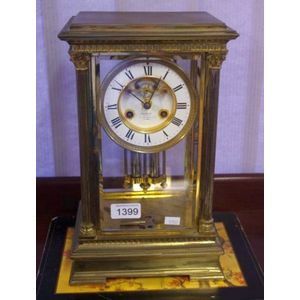Ansonia Brass Mantle Clock with Mercury Regulator Pendulum
You must be a subscriber, and be logged in to view price and dealer details.
Subscribe Now to view actual auction price for this item
When you subscribe, you have the option of setting the currency in which to display prices to $Au, $US, $NZ or Stg.
- Subsidiary Dial - On a clock or watch, a subsidiary dial, also called an auxiliary dial, is a dial that is secondary to the main dial and may show seconds, day of the week or month, or strike silent. A subsidiary dial may be within our outside the main dial, and a clock or watch may have several subsidiary dials.
- Pendulum - The pendulum was discovered around 1602 by Galileo Galilei, and was adopted for time keeping by the Dutch mathematician and natural philosopher, Christiaan Huygens, who excelled in astronomy, physics, and horology.
The pendulum comprises a metal rod usually of brass or steel with a metal disk, known as a bob, at the end. The movement of the pendulum is driven by weights or a spring, and as a pendulum swings in a regular arc, it was found accuracy could be controlled to within a few seconds a week.
Timekeeping can be adjusted by changing the height of the bob on the rod, making the pendulum either swing slower or faster.
The disadvantage of the pendulum was that changes in temperature also changed the length of the pendulum, interfering with the accuracy of the clock, and so in the 18th century two types of mercurial pendulums were invented which countered the movement in the steel rod.
The pendulum was the world's most accurate timekeeping technology until the invention of the quartz clock, regulated by a quartz crystal, in 1927. - Chapter Ring - A separate metal plate on the face of a clock, on which the numerals for the hours and sometimes parts of the hours, are displayed, usually wheel shaped and sitting on top of the dial plate. The chapter ring is often a feature of the clock and can be silvered or enamelled to stand as a contrast to its background. The hours are usually shown in Roman numerals, although in the late 19th and earlt 20th century, Arabic numerals became fashionable.
This item has been included into following indexes:
Visually similar items

A French brass four-glass mantel clock, the restrained case enclosing a movement by S. Marti et Cie, the white enamel dial with annular chapter ring with Roman numerals framing a Brocot type escapement, complete with mercury compensated pendulum, bell stri

A French four glass mantle clock, circa 1860, the four thick bevel edge glass panels with a heavy polished brass case. Exposed escapement, with an eight day movement, striking on gong. Twin tube mercury pendulum.

A brass and glass mantel clock, late 19th to early 20th century, with stamp of Japy Freres to mechanism, the carriage style mantel clock glazed to all sides, with a festoon decorated enamel dial with Arabic numerals set within a finely engine turned bezel,

French 4-glass table regulator, with mercury temperature compensation pendulum marked Ch. Vcne (Chemin de Vincennes?) Dial marked E White of 20 Cockspur st. London
